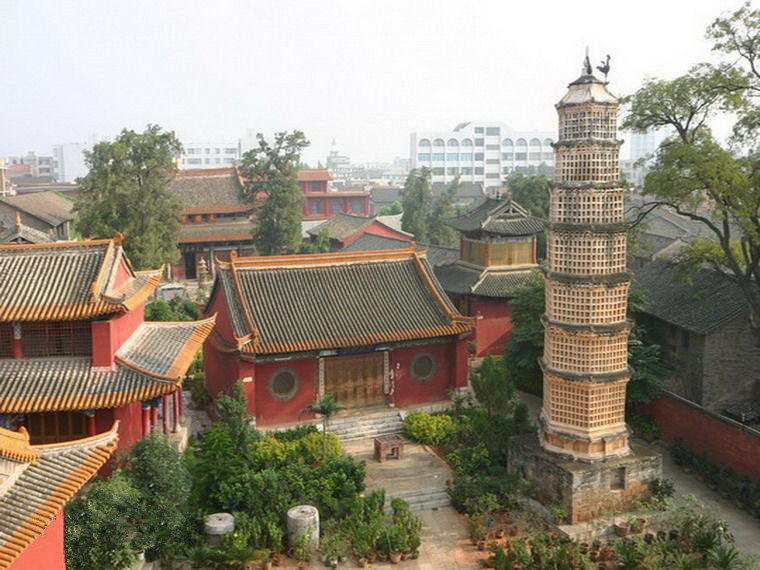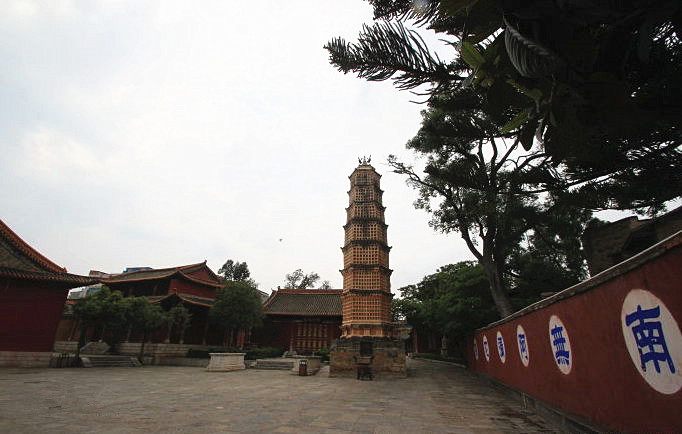Qianfo Pagoda of Dajue Temple in Luliang County, Qujing
The Qianfo Pagoda (千佛塔) is located within Dajue Temple (大觉寺) on Zhenli Street (真理街) in Luliang County (陆良县), Qujing City (曲靖市). This pagoda has a history of around six to seven hundred years. According to the “Luliang County Annals” (陆良县志), the temple was originally built during the Yuan Dynasty (元朝) and was renovated during the Ming Dynasty (明朝) under the Wanli period (万历). In front of the temple, there are drum towers, while the pagoda rises majestically to the east.
Historical Background
The Qianfo Pagoda, originally named the Jinjita (金鸡塔), was built during the Yuan Dynasty and has been well-preserved through successive renovations. The pagoda is constructed from bricks and has a hexagonal shape with seven tiers, reaching a height of 18 meters. It has been designated as a provincial-level key cultural relic protection unit.
The pagoda is adorned with numerous window-like niches containing ceramic Buddha statues, which is why it is also called the “Thousand Buddha Pagoda” (千佛塔). At the top of the pagoda is a bronze kettle, and atop that sits a stone gourd, flanked by two iron-cast golden roosters. The design symbolizes the ancient people’s hopes for a peaceful life.
According to local legend, a fierce shark once caused persistent rain and flooding in the area. Following the advice of a divine being, people built this tall pagoda to subdue the shark, placing the golden roosters on top to monitor its movements. Since then, the area has enjoyed favorable weather, allowing the people to live peaceful lives.
Architectural Features
The Qianfo Pagoda is unique among the pagodas of Yunnan, and its style is rare nationwide, making it particularly attractive.
The pagoda consists of a hexagonal structure with seven tiers, standing at a height of 17.79 meters. Its base is a square stone platform, with niches for Buddha statues on each of its four sides. The main tower narrows progressively from bottom to top, and each of its six faces is constructed from equal-sized bricks, resembling a giant beehive from a distance.
Inside each niche is a brick depiction of Shakyamuni Buddha, seated on a lotus platform, radiating a serene aura. The pagoda has a total of 1,613 niches, which fully justifies its name as the “Thousand Buddha Pagoda.”
Recent Renovations
The most recent renovation of Dajue Temple occurred in 1982, funded by the provincial government. During this restoration, new Buddha statue bricks were crafted based on the remaining originals, and the top of the pagoda was restored with a new Kinnaras (迦楼罗) statue. The entire structure was painted a vibrant gold, enhancing its visual splendor.
Visitor Information
- Address: 143 Zhenli Street, Zhongshu Street, Luliang County, Qujing City, Yunnan Province (云南省曲靖市陆良县中枢街道真理街143号)
- Admission: Free
- Parking: Free parking available at the entrance.
Main Attractions
The main highlight is the Qianfo Pagoda, an ancient structure showcasing exceptional architectural and artistic value. Standing at 18 meters, it consists of three parts: the base, the body, and the finial, all made of bricks, with a unique design. Inside, it houses 1,612 brick Buddha images, earning its name as the “Thousand Buddha Pagoda.”
Suitable for
Whether you are a history and culture enthusiast or someone seeking a tranquil spot to relax, this location is an excellent choice.
Visiting Time
A visit will take approximately one hour, allowing you to appreciate the rich history and cultural heritage.
How to Get There
Luliang County is about a 50-minute drive from Kunming (昆明). You can choose to drive, take a train, or ride a bus.
Travel Tips
While visiting Dajue Temple, you may encounter local elders playing cards, which allows you to experience the leisurely and tranquil lifestyle of the residents. Come here to enjoy a unique day trip in Qujing!
Location:













